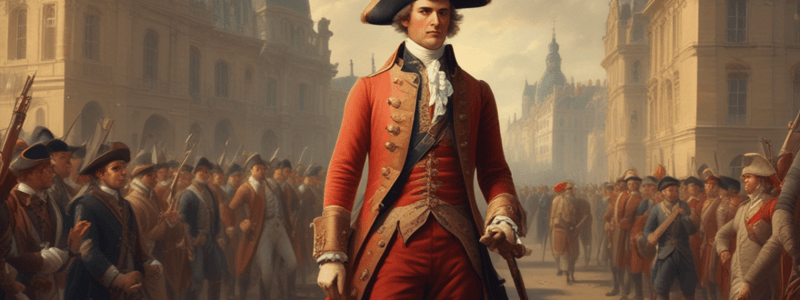Podcast
Questions and Answers
What percentage of the population owned 20% of the land in France during the 1700s?
What percentage of the population owned 20% of the land in France during the 1700s?
- 2% (correct)
- 5%
- 20%
- 10%
What was the primary responsibility of the 1st Estate in France?
What was the primary responsibility of the 1st Estate in France?
- Collecting taxes
- Ruling the country
- Managing trade
- Providing education and helping the poor (correct)
What was a characteristic of the Third Estate in France?
What was a characteristic of the Third Estate in France?
- They were comprised of only the nobility and aristocracy
- They made up the majority of the population and paid most of the taxes (correct)
- They were primarily merchants and traders
- They paid little in taxes
What was a notable aspect of the Bourgeoisie in France?
What was a notable aspect of the Bourgeoisie in France?
What was the approximate percentage of land owned by the Clergy in France?
What was the approximate percentage of land owned by the Clergy in France?
What percentage of the population consisted of peasants?
What percentage of the population consisted of peasants?
Why did the King raise taxes on the Nobility?
Why did the King raise taxes on the Nobility?
What was the outcome of the Third Estate's demand for reform?
What was the outcome of the Third Estate's demand for reform?
Why did the Third Estate break into the Tennis Court?
Why did the Third Estate break into the Tennis Court?
What inspired the French people, according to the text?
What inspired the French people, according to the text?
Flashcards are hidden until you start studying
Study Notes
French Revolution Overview
- France was an advanced nation in the 1700s, with a large population, prosperous trade, and the Enlightenment.
Three Estates in France
- 1st Estate: Clergy, owned 10% of land, paid 2% of income to the government, and received 10% tithes from the people.
- 2nd Estate: Nobility and Aristocracy, owned 20% of the country, paid little in taxes, and opposed Enlightenment ideas.
- 3rd Estate: 97% of the people, paid most of the taxes, consisting of:
- Bourgeoisie (middle class, professionals): educated, supported Enlightenment ideas, and paid high taxes.
- Workers (domestic servants, laborers, factory workers): low wages.
- Peasants (80% of population): paid ½ of income to Nobles, tithes to the Church, and taxes to the king.
Causes of the French Revolution
- Enlightenment ideas of government.
- Serious economic problems:
- Cost of living increased.
- Price of bread doubled in 1789.
- Commerce was almost impossible.
- Extremely high taxes.
- Poor harvests.
- Government debt.
- Weak, indecisive leadership:
- Louis XVI ignored the problem.
- Marie Antoinette gave poor advice.
Estates General
- Assembly of all 3 estates, first time in 175 years.
- Met on May 5, 1789, at Versailles.
- The 3rd Estate demanded:
- One vote per delegate.
- Meeting together with other estates.
- Nobility sided with the king, wanting to maintain medieval rules of voting.
The National Assembly
- Created on June 17, 1789, by the 3rd Estate.
- Abolished the absolute monarchy and began a representative government.
- 3 days later, the 3rd Estate was locked out of the meeting room, leading to the Tennis Court Oath.
- At the Tennis Court, the National Assembly remained until they created a new constitution.
Studying That Suits You
Use AI to generate personalized quizzes and flashcards to suit your learning preferences.



